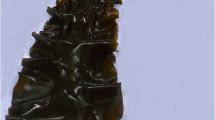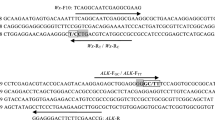Abstract
New variety breeding is very significant for Saccharina japonica cultivation industry. In this paper, we reported the breeding process, evaluation of economic traits, and commercial cultivation of a new Saccharina variety “Huangguan No. 1” (variety approval number: GS-01-006-2011). The sporophytes with best performance were screened out from varieties cultivated throughout Fujian Province, China, and mixed together as the parent population. The “Huangguan No. 1” variety was bred successfully from 5 years of targeted selection of objective traits and continuous progeny selfing/inbreeding. This new variety has a much longer, wider, and thicker blade; faster growth rate; heavier individual weight; and stronger resistance to high temperatures compared to the control variety (p < 0.05). Cultivation tests showed that the economically important traits remained steady in different years and sea areas, implying that “Huangguan No. 1” has the stable genetic basis for its excellent performance. Compared to the control variety, the yield and final product rate of “Huangguan No. 1” increased 30 and 25 %, respectively. Nutritional constituent analysis indicated that “Huangguan No. 1” could be used as a healthy food because of its higher protein (6.85 %) but lower fat content (0.2 %). Heavy metal (As, Cd, Pb) content was lower than the standard content for food safety. The suitability of “Huangguan No. 1” as a food source rather than a raw material for the chemical industry was increased due to the low algin (10.2 %) and iodine content (0.32 %). “Huangguan No. 1” variety was welcomed by farmers and has been commercially cultivated about 13,293 ha.



Similar content being viewed by others
References
Algal Genetic Research Breeding Team of Oceanography Institute of Chinese Academy of Science and Algal Culturing Team of Qingdao Maricultural Institute (1976) Breeding of a novel variety with high yield potential and iodine content. Sci China 5(3):512–517 (in Chinese with English abstract)
Bi YH, Hu YJ, Zhou ZG (2011) Genetic variation of Laminaria japonica (Phaeophyta) populations in China as revealed by RAPD markers. Acta Oceanol Sin 30(2):103–112
Excoffier L, Laval G, Schneider S (2005) Arlequin (version 3.0), an integrated software package for population genetics data analysis. Evol Bioinform Online 1:47–50
Fang TC, Wu CY, Jiang BY, Li JJ, Ren GZ (1962) The breeding of a new breed of Haidai (Laminaria japonica Aresch.) and its preliminary genetic analysis. Acta Bot Sin 10(3):197–209 (in Chinese with English abstract)
Fang TC, Qu YL, Cui JJ (1985) Breeding of hybrid Laminaria “Danza No. 10”—an application of the Laminaria haploid cell clones. J Shandong Coll Oceanol 15(1):64–72 (in Chinese with English abstract)
Li XJ, Cong YZ, Yang GP et al (2007) Trait evaluation and trial cultivation of Dongfang No. 2, the hybrid of a male gametophyte clone of Laminaria longissima (Laminarales, Phaeophyta) and a female one of L. japonica. J Appl Phycol 19:139–151
Li XJ, Liu JL, Cong YZ et al (2008) Breeding and trial cultivation of Dongfang No. 3, a hybrid of Laminaria gametophyte clones with a more than intraspecific but less than interspecific relationship. Aquaculture 280:76–80
Liu FL, Wang XL, Yao JT, Duan DL (2010) Development of expressed sequence tag-derived microsatellite markers for Laminaria japonica Aresch. J Appl Phycol 22:109–111
Liu FL, Yao JT, Wang XL et al (2012a) Genetic diversity and structure within and between wild and cultivated Saccharina japonica (Laminariales, Phaeophyta) revealed by SSR markers. Aquaculture 358(359):139–145
Liu FL, Wang FJ, Duan DL (2012b) EST-SSR markers derived from Laminaria digitata and its transferable application in Saccharina japonica. J Appl Phycol 24:501–505
Miller MP (1997) Tools for population genetic analyses (TFPGA) 1.3, a Windows program for the analysis of allozyme and molecular population genetic data. Computer software distributed by author
Nei M (1978) Estimation of average heterozygosity and genetic distance from a small number of individuals. Genetics 89:583–590
Shan TF, Pang SJ, Zhang YR, Yakovleva IM, Skriptsova AB (2011) An AFLP-based survey of genetic diversity and relationships of major farmed cultivars and geographically isolated wild populations of Saccharina japonica (Phaeophyta) along the northwest coasts of the Pacific. J Appl Phycol 23:35–45
Sheng XF, Zhao YF, Shang DR, Ning JS, Guo YY (2011) Differences in the major nutrition constituents and major elements in the kelp of different growing stages. Food Sci Technol 12(12):66–68 (in Chinese with English abstract)
Tian ZP, Yuan BJ (1989) Breeding of the new variety Zaohoucheng No.1 of Laminaria japonica. Mariculture 37(1):7–17 (in Chinese)
Tseng CK (2001) Algal biotechnology industries and research activities in China. J Appl Phycol 13:375–380
Tseng CK, Wang S, Liu SJ, Guo XK, Zhang DM, Miao GR (1984) Seaweeds cultivation. Shanghai Science and Technology Press, Shanghai, p 218
Wu CY, Lin GH (1987) Progress in the genetics and breeding of economic seaweeds in China. Hydrobiologia 151(152):57–61
Yeh FC, Yang RC, Boyle T (1999) POPGENE version 1.32, Microsoft window-base software for population genetic analysis, a quick user’s guide. University of Alberta, Center for International Forestry Research, Alberta, Canada
Zemke-White WL, Ohno M (1999) World seaweed utilization: an end-of-century summary. J Appl Phycol 11:369–376
Zhang QS, Tang XX, Cong YZ, Qu SC, Luo SJ, Yang GP (2007) Breeding of an elite Laminaria variety 90-1 through inter-specific gametophyte crossing. J Appl Phycol 19:303–311
Acknowledgments
This work was funded by Public Service industry (Agriculture) Special Research Fund (200902030), National High Technology Research and Development program (2012AA10A406), National Natural Science Foundation of China (41306176), and Shandong Natural Science Foundation (ZR2012CQ030). We thank Dr. Sheryl Miller for English language revise and also thank the anonymous reviewers for their suggestions to this paper.
Author information
Authors and Affiliations
Corresponding author
Additional information
Fuli Liu and Xiutao Sun have contributed equally to this paper.
Rights and permissions
About this article
Cite this article
Liu, F., Sun, X., Wang, F. et al. Breeding, economic traits evaluation, and commercial cultivation of a new Saccharina variety “Huangguan No. 1”. Aquacult Int 22, 1665–1675 (2014). https://doi.org/10.1007/s10499-014-9772-8
Received:
Accepted:
Published:
Issue Date:
DOI: https://doi.org/10.1007/s10499-014-9772-8




